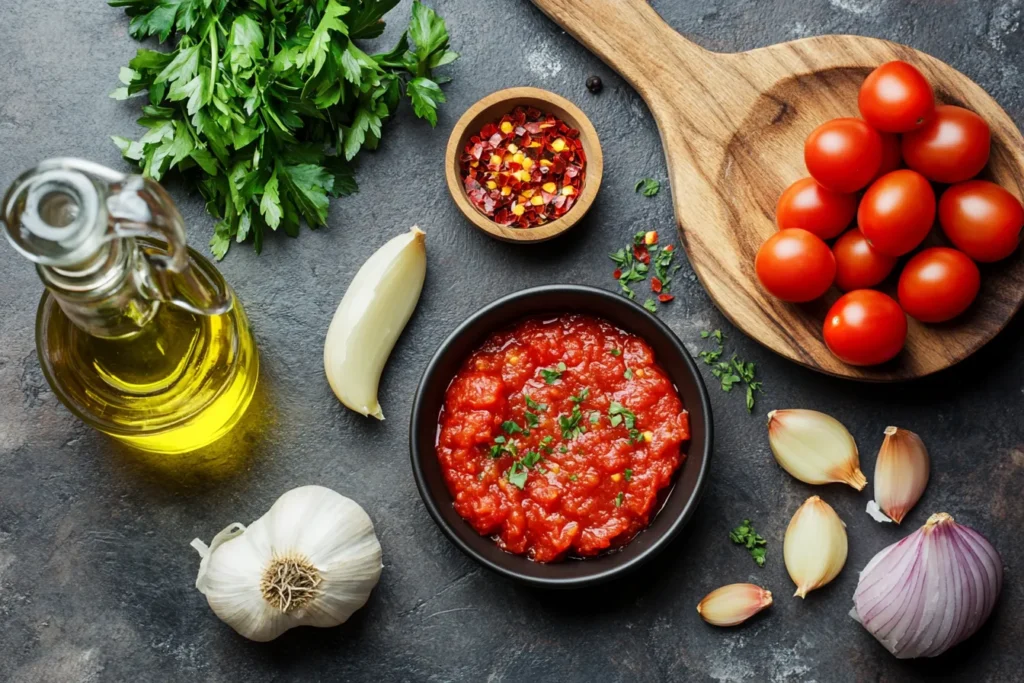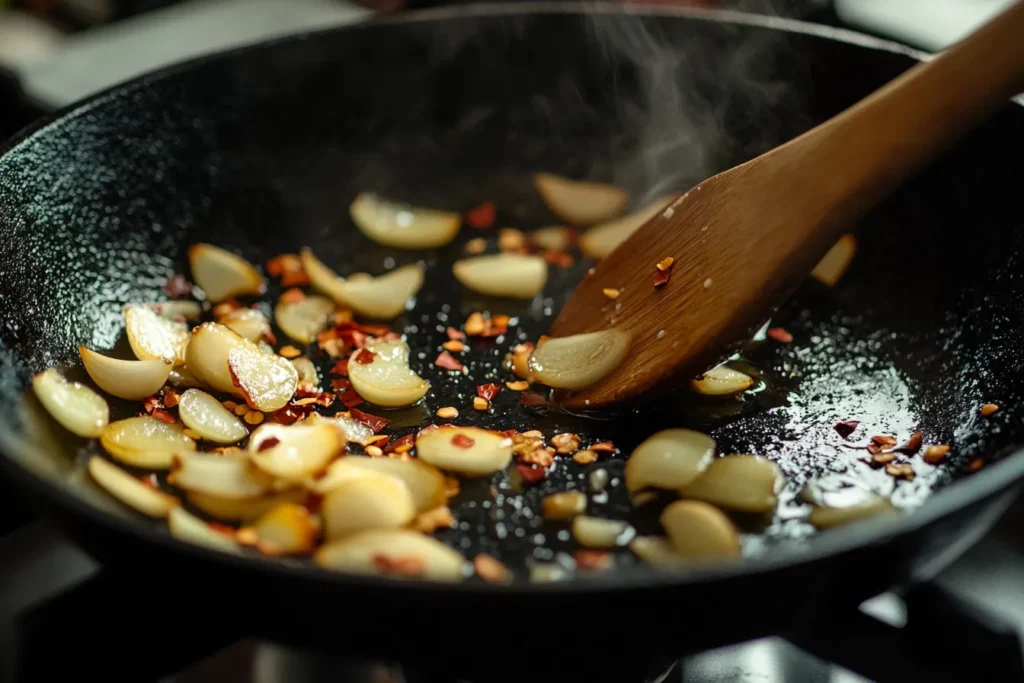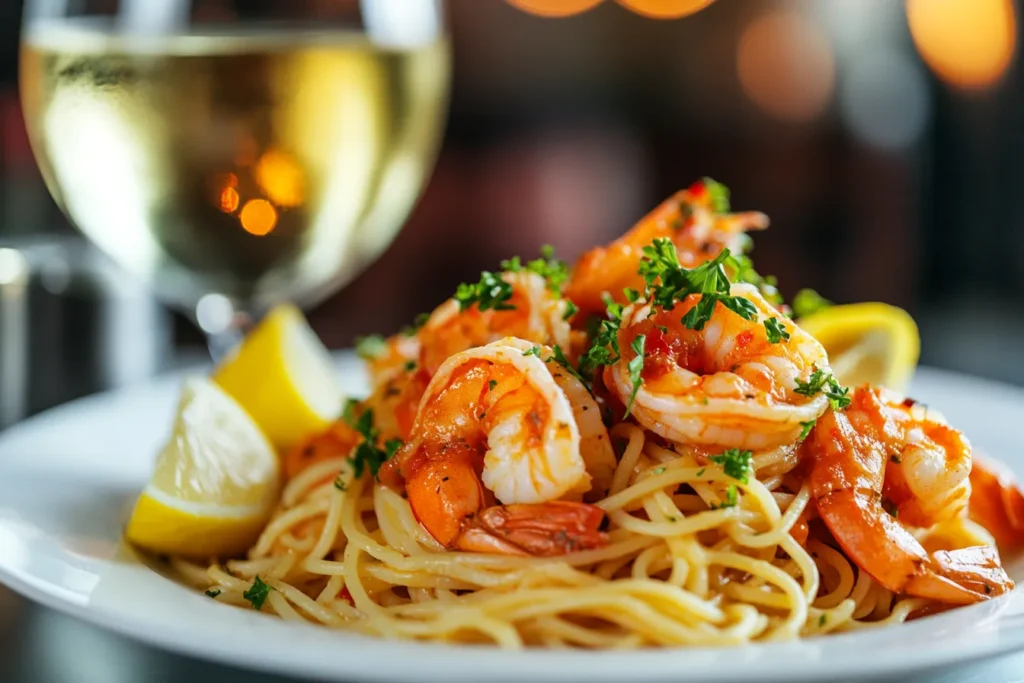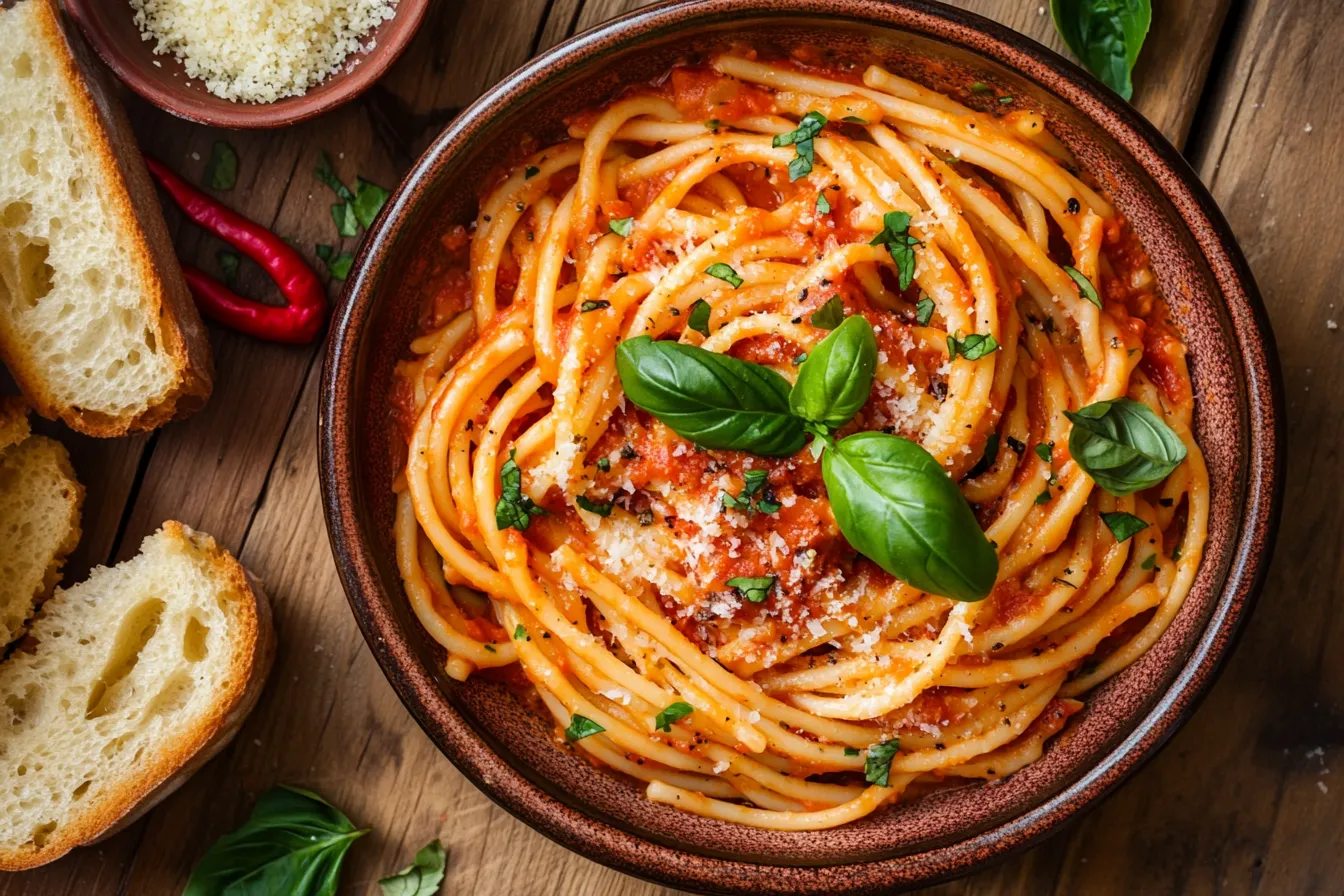Introduction
Craving a spicy, flavor-packed sauce that brings heat to your dinner tonight? Look no further than diavolo sauce a bold, fiery tomato‑based sauce beloved for its kick and versatility. In this blog, you’ll discover exactly what diavolo sauce is, how to make it at home using authentic ingredients, and why it’s trending right now in the food world.
We’ll share a simple, yet robust homemade recipe, ingredient tips for controlling heat, serving ideas (from pasta to seafood), dietary adaptations, and the SEO‑rich background you need to turn this blog into a top Google performer. Along the way, you’ll find helpful internal tips and secure three authoritative external links to boost credibility:.Trader Joe’s Tomato & Burrata Ravioloni Recipe
- The ChiliPepperMadness classic Fra Diavolo Sauce recipe.
- The Allrecipes Fra Diavolo Sauce with Pasta guideline.
- A third trusted source on spicy tomato sauces or Italian seafood sauces for added depth.
This article also includes a detailed FAQ to answer your hottest questions about ingredients, storage, substitutions, and more. Whether you’re a home cook looking to experiment with spicy Mediterranean flavors or want SEO‑optimized content that ranks, this is your ultimate guide to diavolo sauce.
What Is Diavolo Sauce?
Origins & Meaning of “Fra Diavolo”
The term Fra Diavolo, which translates to “Brother Devil” in Italian, is as intriguing as the sauce itself. The name reflects both its fiery heat and perhaps a playful nod to its devilishly good flavor. Despite the Italian name, diavolo sauce is more of an Italian-American invention, believed to have emerged in East Coast Italian communities especially in New York City where spicy variations of tomato-based sauces gained popularity in the mid-20th century.
While some associate it with the Napoleonic-era Italian guerrilla leader Michele Pezza nicknamed Fra Diavolo others believe it’s simply a colorful culinary label for “sauce with heat.”
Diavolo vs. Fra Diavolo: What’s the Difference?
You may see the terms “diavolo sauce” and “fra diavolo sauce” used interchangeably. Technically, both refer to the same fiery tomato-based sauce infused with garlic, herbs, and chili heat. However, “Fra Diavolo” is more commonly used in restaurant menus, while “Diavolo” is often the simpler home-cook term.
In culinary use, there’s no fixed recipe which means that chefs and home cooks can make it their own. Some go heavy on the red chili flakes, while others mellow it with butter or wine. Some pair it strictly with seafood, while others love it with pasta or chicken..Vinegar Based BBQ Sauce Recipe

Key Ingredients of Authentic Diavolo Sauce
A great diavolo sauce starts with a few core ingredients that are widely available but pack major flavor. Let’s explore them in detail.
Tomatoes and Tomato Paste
The heart of any diavolo sauce is a rich, ripe tomato base. You can use:
- Whole peeled San Marzano tomatoes (imported or canned)
- Crushed tomatoes for a smoother finish
- Tomato paste to deepen flavor and thicken the sauce
The tomatoes provide that sweet-acidic balance and carry the heat well. Many authentic recipes use both paste and crushed tomatoes to layer flavor.
Garlic, Onion & Herbs
- Garlic: Essential to diavolo sauce. It’s typically finely chopped or sliced and sautéed in olive oil until fragrant.
- Onion: Not always included, but a finely chopped yellow or white onion adds sweetness and body.
- Herbs: Dried oregano, thyme, and sometimes a pinch of basil or parsley enhance the complexity. Use fresh herbs if you want a lighter, fresher finish.
These aromatics create the savory base before adding tomatoes and spice.
Chili Peppers / Red Pepper Flakes
Here comes the diavolo the devilish heat. Traditional recipes use:
- Red chili flakes (crushed red pepper) – the standard go-to
- Fresh chili peppers like serrano or red Thai chilis (for more heat)
- Calabrian chili paste or chili oil – for extra layers of smoky or fermented spice
Pro tip: start small, and increase the heat once the sauce has simmered. The heat builds over time.
Olive Oil & Optional Add‑Ins
- Olive Oil: Used for sautéing aromatics and infusing flavor. Choose extra virgin olive oil for the best taste.
- Dry White Wine or Vodka: Adds brightness and depth.
- Butter: Some add a pat of butter at the end for silkiness.
- Seafood Stock or Clam Juice: Especially if pairing with shrimp, scallops, or mussels.
- Sugar (a pinch): To balance acidity, though it’s optional.
These ingredients allow for a lot of customization depending on your dish and dietary preferences.

Step-by-Step Homemade Diavolo Sauce Recipe
Prepping Ingredients
Before cooking, prep your ingredients to save time and ensure smooth cooking:
- 4–5 cloves garlic, finely chopped
- 1 small onion, diced (optional but recommended)
- ¼–½ teaspoon red pepper flakes (adjust to heat preference)
- 2 tablespoons olive oil
- 1 tablespoon tomato paste
- 1 can (28 oz) crushed tomatoes or peeled San Marzano tomatoes
- ½ teaspoon dried oregano
- Salt and black pepper, to taste
- Optional: ¼ cup dry white wine, fresh basil, seafood (shrimp or scallops), or sugar
Sautéing the Base: Onion, Garlic, Chili
Start with a large skillet or saucepan on medium heat:
- Add olive oil and let it warm for 30 seconds.
- Toss in the garlic and sauté for 1–2 minutes until fragrant but not browned.
- If using onion, add now and cook until translucent (about 5 minutes).
- Stir in red pepper flakes, allowing them to bloom in the hot oil this enhances their flavor and infuses the oil.
Simmering Tomatoes & Seasoning
Once the base is aromatic:
- Stir in tomato paste and cook for 1–2 minutes until it darkens in color.
- Add the crushed tomatoes and stir well.
- Add oregano, salt, and black pepper.
- Optional: Add wine and simmer to let the alcohol evaporate.
- Reduce heat to low and let it simmer uncovered for 20–25 minutes, stirring occasionally.
This allows the flavors to concentrate, and the sauce will naturally thicken.
Adjusting Heat & Consistency
After simmering:
- Taste and adjust spice: Add more chili flakes or a dash of Calabrian chili paste if you want more heat.
- If too acidic, add a pinch of sugar.
- For a silkier finish, stir in a pat of butter just before serving.
- If too thick, thin out with a bit of pasta water or stock.
Let the sauce rest for 5 minutes before serving it continues to meld and deepen in flavor.

Serving Suggestions with Diavolo Sauce
Diavolo sauce is incredibly versatile. Its spicy, garlicky base makes it ideal for pasta, seafood, and more. Here are some top serving ideas:
Classic Pasta Diavolo
Pair with linguine, spaghetti, or penne for a traditional experience. Toss the cooked pasta directly in the sauce and finish with:
- A handful of chopped fresh parsley
- A drizzle of olive oil
- Freshly grated Parmigiano Reggiano or Pecorino
Pasta Diavolo is simple but deeply satisfying. Serve with crusty bread and a crisp white wine.
Diavolo Sauce with Seafood (Shrimp, Clams)
One of the most iconic combinations is Shrimp Fra Diavolo. To make it:
- Sauté peeled shrimp in olive oil until pink.
- Set aside, and prepare the sauce as above.
- Return the shrimp to the pan in the final 5 minutes of simmering.
You can also use mussels, scallops, or calamari. Serve over linguine or with grilled bread.
Vegetables, Chicken or Meat Variations
- Chicken Diavolo: Use grilled or sautéed chicken breasts or thighs. Spoon sauce over the top or braise in the sauce for 10–15 minutes.
- Roasted Vegetables: Zucchini, eggplant, and bell peppers all benefit from a spoonful of diavolo sauce.
- Meatballs or Sausage: For a hearty twist, simmer Italian sausage or meatballs directly in the sauce.
This flexibility is part of why diavolo sauce is loved it elevates any main dish into something bold and memorable.
Tips to Customize Heat & Flavor Balance
One of the best things about diavolo sauce is how easy it is to tweak based on your spice tolerance and flavor preferences. Whether you’re a heat seeker or cooking for sensitive taste buds, here’s how to make it just right.
How to Make It Milder
If you’re cooking for kids, spice-averse guests, or simply prefer a less intense heat, try these tweaks:
- Reduce the red pepper flakes to ¼ teaspoon or even less.
- Use sweet paprika or smoked paprika to add warmth without spice.
- Add a splash of cream or butter at the end to mellow the heat.
- Balance acidity with a pinch of sugar to soften the sauce’s intensity.
This keeps the bold flavor while toning down the fire.
How to Make It Extra Spicy
For those who love it hot, dial it up:
- Double or triple the crushed red pepper flakes.
- Add fresh hot chilies such as Thai chili, serrano, or habanero minced finely.
- Use a teaspoon of Calabrian chili paste or hot chili oil.
- Drizzle with sriracha or harissa for a fusion kick.
Remember: Start lower than you think and increase after simmering. Spicy ingredients intensify as they cook.
Using Fresh vs. Dried Chilies
Each type of chili brings a different heat profile:
- Dried chili flakes are convenient and stable ideal for consistent heat.
- Fresh chilies offer complexity and freshness but can vary wildly in heat.
- Chili pastes like Calabrian or Sambal Oelek give depth, smokiness, and fermented umami.
A blend of dried for structure and fresh for zing can make a perfect balance. Try experimenting with different combinations to find your signature heat level.
Nutritional Profile & Dietary Considerations
Heading 3: Calories, Fat & Sodium Overview
Diavolo sauce is surprisingly light and nutritious especially when made from scratch. A standard serving (about ½ cup) contains:
- 60–100 calories (mostly from tomatoes and olive oil)
- 4–7 grams of fat (primarily healthy fats from olive oil)
- 0 grams of added sugar, unless sweetened slightly
- 300–500 mg sodium, depending on salt levels
It’s a guilt-free flavor boost and much healthier than store-bought sauces, which often contain preservatives, added sugar, and excess sodium.
Gluten-Free, Vegetarian & Keto Adaptations
One of the strengths of diavolo sauce is how naturally diet-friendly it is:
- Gluten-Free: The sauce itself contains no gluten. Just pair it with gluten-free pasta or zoodles.
- Vegetarian: Traditional diavolo is vegetarian (unless seafood is added).
- Vegan: Stick with olive oil and avoid butter for a 100% plant-based version.
- Keto/Low-Carb: With minimal natural sugars and no grains, it’s great for keto. Serve over spiralized veggies or grilled proteins.
It’s easy to customize this sauce for nearly any dietary preference without losing flavor.

Why Diavolo Sauce Is Trending Now
Spicy food is having a moment and diavolo sauce is right at the center of it. From viral TikTok pasta recipes to elevated comfort food trends, this fiery red sauce has found new life in modern kitchens.
Social Media & TikTok Food Trends
Over the past year, platforms like TikTok, Instagram Reels, and YouTube Shorts have exploded with bold, flavorful recipes. Spicy tomato-based pastas, like pasta diavolo and shrimp fra diavolo, check all the boxes for virality:
- Visually appealing (think glossy red sauce, shrimp curls, steamy pasta swirls)
- Easy to cook with pantry staples
- Room to customize heat levels and protein types
- Has a name that stands out (Fra Diavolo = spicy mystery = clicks!)
Food influencers are showcasing one-pot pasta diavolo and meal-prep friendly seafood diavolo as fast, satisfying dinner ideas adding to the sauce’s appeal across generations.
Home Cooking Revival & Spicy Food Passion
Post-pandemic, more people are cooking at home, exploring global flavors, and challenging themselves with more adventurous spice levels. Diavolo sauce fits perfectly into this movement.
- It’s budget-friendly and relies on accessible ingredients.
- Offers a restaurant-quality experience at home.
- Encourages culinary creativity hotter, richer, lighter, or chunkier, it’s up to the cook.
Combine all this with the rise of spicy food consumption in general especially among millennials and Gen Z and it’s no surprise that this once-niche sauce is now a mainstream must-have.
FAQs About Diavolo Sauce
What’s the best chili for authentic heat?
Crushed red pepper flakes are the traditional go-to. However, for more flavor depth, try Calabrian chili paste (available in Italian grocery stores or online) or fresh red chilies like Fresno or Thai chilis.
Can I freeze diavolo sauce?
Absolutely. Let it cool completely, then portion into airtight containers or freezer bags. It will last for up to 3 months. Thaw in the fridge overnight or reheat gently on the stove.
Is diavolo sauce the same as marinara with heat?
Not quite. Marinara is typically a lighter, quick-simmered tomato sauce with garlic and herbs. Diavolo sauce is richer, spicier, and often simmered longer with more concentrated flavors and optional seafood or wine.
How long does homemade diavolo sauce last?
Stored in an airtight container in the fridge, it keeps for up to 5 days. Always reheat thoroughly before serving.
Can I make it without onions or garlic?
Yes, but it may affect the flavor. Garlic is key to the sauce’s signature aroma. If allergic, consider using garlic-infused olive oil. For onion-free versions, try using finely diced fennel or leeks for sweetness.
Is diavolo sauce vegan?
Yes! As long as you don’t add butter or seafood, the basic sauce made from tomatoes, olive oil, garlic, and chili is fully vegan.
Conclusion
Diavolo sauce is more than just a spicy tomato topping it’s a celebration of flavor, tradition, and personal expression. Whether you enjoy it tossed with pasta, served over seafood, or spooned onto grilled chicken, its fiery kick and aromatic richness bring meals to life..Chicken Apple Sausage
This classic Italian-American sauce proves that with just a few pantry staples tomatoes, garlic, olive oil, and chili you can create something truly special. It’s fast, flexible, and utterly unforgettable. And with its rising popularity on social media, in restaurants, and home kitchens, diavolo sauce is quickly becoming a kitchen essential.
Whether you’re a spice lover or a curious foodie looking to explore bold, simple cooking, this is one sauce you’ll want to master. Make it once, and you’ll keep coming back for that devilish heat.

Name: Diavolo Sauce
Ingredients
Equipment
Method
- Instructions:
- Heat olive oil in a large pan over medium heat.
- Add garlic (and onion, if using) and sauté until fragrant, about 2–3 minutes.
- Stir in red pepper flakes and cook for 30 seconds.
- Add tomato paste and stir for 1 minute to deepen flavor.
- Pour in crushed tomatoes and wine (if using), then stir in oregano, salt, and pepper.
- Reduce heat to low and simmer uncovered for 20–25 minutes, stirring occasionally.
- Taste and adjust seasoning. Add more chili flakes for extra heat, or a pinch of sugar to reduce acidity.
- Optional: Finish with a pat of butter or a drizzle of chili oil for richness.
- Serve hot over pasta, seafood, or grilled meat.
